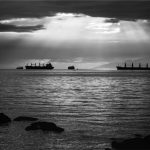
If you’ve ever had the misfortune to encounter wildlife with your car, you’ll know the damage that can occur. Both to the car and the wildlife. Given the speed and the size of a vehicle, often it’s the wildlife who fare the worst, but change the equation and make the vehicle a bike, and the outcome can change considerably for the person.
In the early 90’s, Nate Llerandi featured a few times leading the swim leg of the famous Hawaiian Ironman triathlon. Today he’s a husband, father, triathlon coach and anti-doping campaigner residing in Boulder, Colorado in the US. Boulder is a city full of outdoor enthusiasts located in the foothills of the Rocky Mountains. It’s a location that features plenty of year-round recreation activities.
Earlier in the year, Nate was out for an early morning ride in the hills around Boulder. After ascending some gravel and dirt trails, he exited onto a paved road locally known as Flag to begin his descent home. Here he had the misfortune to have an unwanted wildlife encounter on his bike, smashing into a stationary deer. Nate’s last check of his speedo before impact had him travelling at 35 miles per hour.
Around a blind sweeping curve, I was mid-lane and not near my limit. I hadn’t seen a single rider nor car the entire time, a rarity. The road was clear until, suddenly, it wasn’t. As I slingshot out of the curve, a massive buck stood idly in my path. Left with no time to think or react, I T-boned it mid-torso. The snapshot of this beast that I have in my head includes a massive antler rack; he was no juvenile and had to be 250-300lbs.
I wish I had camera footage of the impact, because the fallout had to have been spectacular. Based on my injuries, I can’t really piece it together. The best I can guess, after slamming into the buck, I launched up and summersaulted over him. Landing with a thud and a loud grunt as the air left my lungs from the impact, insult was added to injury as the buck then tumbled over me. He proceeded to skitter down the road before popping up on to his feet, bounding over the guardrail and disappearing down the steep mountainside.
After struggling back to his feet, Llerandi surveyed a cracked helmet, shredded bib, bloodied nose, pavement rash, screaming tailbone, backside, and hamstring. He composed himself, saddled his damaged bike and rolled downward toward home. His wife promptly took him to an Urgent Care clinic, where they checked him for internal bleeding and concussion. Luckily, it was mostly rash and cracked ribs. Though the next day his backside swelled to the size of a watermelon, and that whole area turned various shades of purple.
There is some overlap between an athletic coach and financial adviser. They are different areas, but at a high level they both assess where someone currently stands and then devise plans and programs, based on a person’s goals, to help them achieve whatever their ideal outcomes are. Both a coach and adviser should be a reliable source of information and ongoing guidance. They can also offer up some useful life lessons based on theirs, or someone else’s, experience.
Nate’s taken some lessons from his experience with the deer. Two are particularly useful, not only from a physical perspective, but also a financial one.
In the days after the crash, Llerandi decided not to lay around and wait for the pain and discomfort to subside, but to get moving again. Attempting to find out the range of movements that were possible, where his body’s current limits were, and to also aid his recovery. He likes to say “nature abhors a vacuum”, suggesting that unless we make the effort to continually move, and stay active as best we can, we will quickly fall into decline.
There’s a lesson here for investors and particularly investors who might be feeling outmatched by poor experiences.
A number of people had their first taste of investing over the past few years. Due to covid, free money was floating around, there was even more free time for some people and investing became appealing. After the initial Covid tumble, the market went on an upward tilt and the inexperienced thought they couldn’t lose. Initially, they probably couldn’t. As time crept on, reality reemerged.
After having their reality distorted by picking some early winners, plenty of young investors are now scratching their heads and rubbing their wounds. They’re sitting on significant losses from speculative stocks and wondering where they go from here. It’s not hard to find people online admitting to losses in the tens of thousands, asking for advice on what they should do next.
They need to accept it happened and move on. Quickly. If the investor was doing some high stakes speculation and lost, that money’s not coming back. It’s a painful, but important lesson. They won’t be able to consistently pick the right stocks or time the market regularly to do better than the market itself. Yes, anyone can hit a winner here and there, but that usually just increases someone’s confidence about their chances of being successful long term. Soon they’re wrongfooted and losing a lot of money again.
Sitting around feeling sorry for oneself won’t make the money come back, just like laying around in bed after a crash won’t speed a recovery. Confidence won’t just reappear. Investors need to understand what they’re capable of, and get moving again.
Of course, ‘moving again’ doesn’t mean repeating the same mistakes. It means building an evidence based, tax efficient and globally diversified portfolio. Something they can contribute to on a regular basis, and stick with over the long term.
The other lesson is risk. Llerandi’s been riding the roads and trails around Boulder for over 30 years, and estimates he’s ridden the Flag descent a couple thousand times. Boulder is an area known for its wildlife. Moose, Deer, Black Bears, Mountain Lions, Bobcats. They’re all in the bushes and forests somewhere. Sometimes they make a surprise appearance, and they’re all critters you’d prefer to avoid a surprise interaction with. It’s the first time Llerandi has had this type of close encounter with wildlife.
Good times so far, doesn’t mean good times into the future. It’s the old past performance reminder. It’s also a reminder that risk doesn’t decrease with time. It just means there’s not been a problem yet, and it’s a mistake to discount the prospect of one. This goes for every investment and every strategy. From speculative rubbish to an evidence-based portfolio.
An investor may get lucky doing something reckless, but danger delayed is not danger denied. Similarly, advisers occasionally have issues with investors who don’t want to rebalance their portfolio when the sharemarket’s been on a consistent run upward. Things feel good, why change? Because rules manage risk. If a market or financial target has been met there’s no reason to leave that money exposed because of a feeling. Risk doesn’t decrease just because the market went up.
A reminder surprises can be around every corner. The best we can do is be prepared and if the worst occurs, have the confidence to get back on our bikes again.
This article is for informational purposes only and the information contained is of a general nature and may not be relevant to your particular circumstances. The circumstances of each investor are different, and you should seek advice from a professional financial adviser who can consider if particular strategies and products are right for you. In all instances where information is based on historical performance, it is important to understand this is not a reliable indicator of future performance. You should not rely on any material on this website to make investment decisions and should seek professional advice.





